Quality Analysis of Natural Gas Using the Structural Reliability of an Analytical Information System
Abstract
1. Introduction
2. Materials and Methods
2.1. General Structure of the Proposed System
2.2. Numerical Results for Structural Reliability
3. Results
3.1. Preliminary Definitions
3.2. The Proposed Reliability Model for the Measurement of a Single Parameter of Gas Mixture
3.3. Preliminary Study: The Reliability of a Measurement Subsystem When n = 1
4. Discussion
5. Conclusions
Author Contributions
Funding
Data Availability Statement
Acknowledgments
Conflicts of Interest
References
- Kashyzadeh, K.R.; Koloor, S.S.R.; Bidgoli, M.O.; Petrů, M.; Asfarjani, A.A. An Optimum Fatigue Design of Polymer Composite Compressed Natural Gas Tank Using Hybrid Finite Element-Response Surface Methods. Polymers 2021, 13, 483. [Google Scholar] [CrossRef] [PubMed]
- Nouri, M.; Ashenai-Ghasemi, F.; Rahimi-Sherbaf, G.; Kashyzadeh, K.R. Experimental and numerical study of the static performance of a hoop-wrapped CNG composite cylinder considering its variable wall thickness and polymer liner. Mech. Compos. Mater. 2020, 56, 339–352. [Google Scholar] [CrossRef]
- Reza Kashyzadeh, K.; Marusin, A.V. Service Life Prediction of Type-IV Composite CNG Cylinder under the Influence of Drivers’ Refueling Habits—A Numerical Study. Polymers 2023, 15, 2480. [Google Scholar] [CrossRef] [PubMed]
- Brokarev, I.A.; Vaskovskii, S.V. Distributed data gathering system to analyze natural gas composition. Adv. Syst. Sci. Appl. 2019, 19, 14–24. [Google Scholar]
- Brokarev, I.A.; Vaskovskii, S.V. Multi-criteria estimation of input parameters in natural gas quality analysis. Adv. Syst. Sci. Appl. 2020, 20, 60–69. [Google Scholar]
- GOST (State Standard) 27.002−89; Reliability in Technology. Main Terms and Definitions. Standardinform Publisher: Geneva, Switzerland, 1990; p. 40. (In Russian)
- Lavrisheva, E.M.; Pakulin, N.V.; Rizhov, A.G.; Zelenov, S.V. How to analyze methods to assess reliability of systems and tools. Work. ISP RAS 2018, 30, 99–120. [Google Scholar] [CrossRef] [PubMed]
- Konesev, S.G.; Khasieva, R.T. Methods to estimate the reliability of complex systems. Mod. Probl. Sci. Educ. 2015, 1, 2–3. [Google Scholar]
- Osipov, L.V.; Petrov, V.V. On how to estimate a residue in the central limit theorem. Probab. Its Appl. 1967, 12, 322–329. [Google Scholar]
- Kalimulina, E.Y. Analysis of system reliability with control, dependent failures, and arbitrary repair times. Int. J. Syst. Assur. Eng. 2017, 8, 1–9. [Google Scholar] [CrossRef]
- Kalimulina, E.Y. A new approach for dependability planning of network systems. Int. J. Syst. Assur. Eng. 2013, 4, 215–222. [Google Scholar] [CrossRef]
- Kalimulina, E.Y. Math Modeling of the Reliability Control and Monitoring System of Complex Network Platforms. In Intelligent Systems Design and Applications: 18th International Conference on Intelligent Systems Design and Applications (ISDA 2018), Vellore, India, 6–8 December 2018; Springer: Cham, Switzerland, 2018; Volume 2, pp. 230–237. [Google Scholar]
- Granig, W.; Faller, L.M.; Zangl, H. Sensor system optimization to meet reliability targets. Microelectron. Reliab. 2018, 87, 1–37. [Google Scholar] [CrossRef]
- Kalimulina, E.Y. Analysis of Unreliable Open Queueing Network with Dynamic Routing. In Proceedings of the International Conference on Distributed Computer and Communication Networks, Moscow, Russia, 25–29 September 2017; Volume 700, pp. 355–367. [Google Scholar]
- Andreev, A.V.; Yakovlev, V.V.; Korotraya, T.Y. Theoretical Foundations of Technical Reliability; Polytechnic University Publisher: Tomsk, Russia, 2018; p. 164. (In Russian) [Google Scholar]
- Oksendal, B. Stochastic Differential Equations. In An Introduction with Applications; Springer: Berlin/Heidelberg, Germany, 2003; p. 352. [Google Scholar]
- Koralov, L.; Sinai, Y.G. Theory of Probability and Random Processes; Springer Science & Business Media: Berlin/Heidelberg, Germany, 2007; p. 358. [Google Scholar]
- ISO 6976:1995; International Standard. Natural Gas—Calculation of Calorific Value, Density and Relative Density. International Organization for Standardization: Geneva, Switzerland, 1995; p. 46.
- Ibragimov, I.A.; Hasminsky, R.Z. Statistical Estimation. Asymptotic Theory, Applications of Mathematics; Springer: Berlin/Heidelberg, Germany, 1981; p. 403. [Google Scholar]
- Olatubosun, S.A.; Smidts, C. Reliability analysis of passive systems: An overview, status and research expectations. Prog. Nucl. Energy 2022, 143, 104057. [Google Scholar] [CrossRef]
- Ayodeji, A.; Amidu, M.A.; Olatubosun, S.A.; Addad, Y.; Ahmed, H. Deep learning for safety assessment of nuclear power reactors: Reliability, explainability, and research opportunities. Prog. Nucl. Energy 2022, 151, 104339. [Google Scholar] [CrossRef]
- Naess, A.; Leira, B.J.; Batsevych, O. System reliability analysis by enhanced Monte Carlo simulation. Struct. Saf. 2009, 31, 349–355. [Google Scholar] [CrossRef]
- Sundar, V.S.; Ammanagi, S.; Manohar, C.S. System reliability of randomly vibrating structures: Computational modeling and laboratory testing. J. Sound Vib. 2015, 351, 189–205. [Google Scholar] [CrossRef]
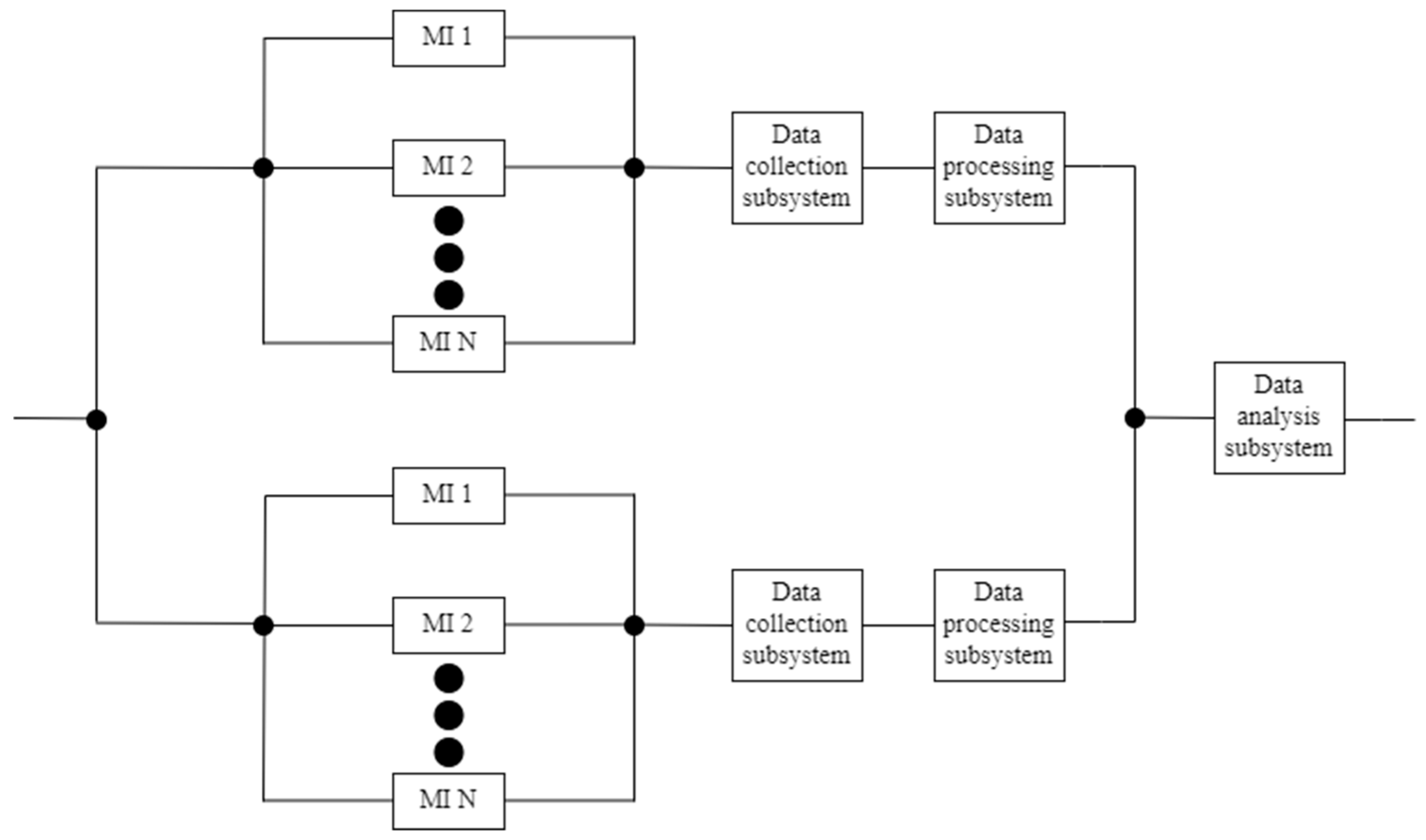
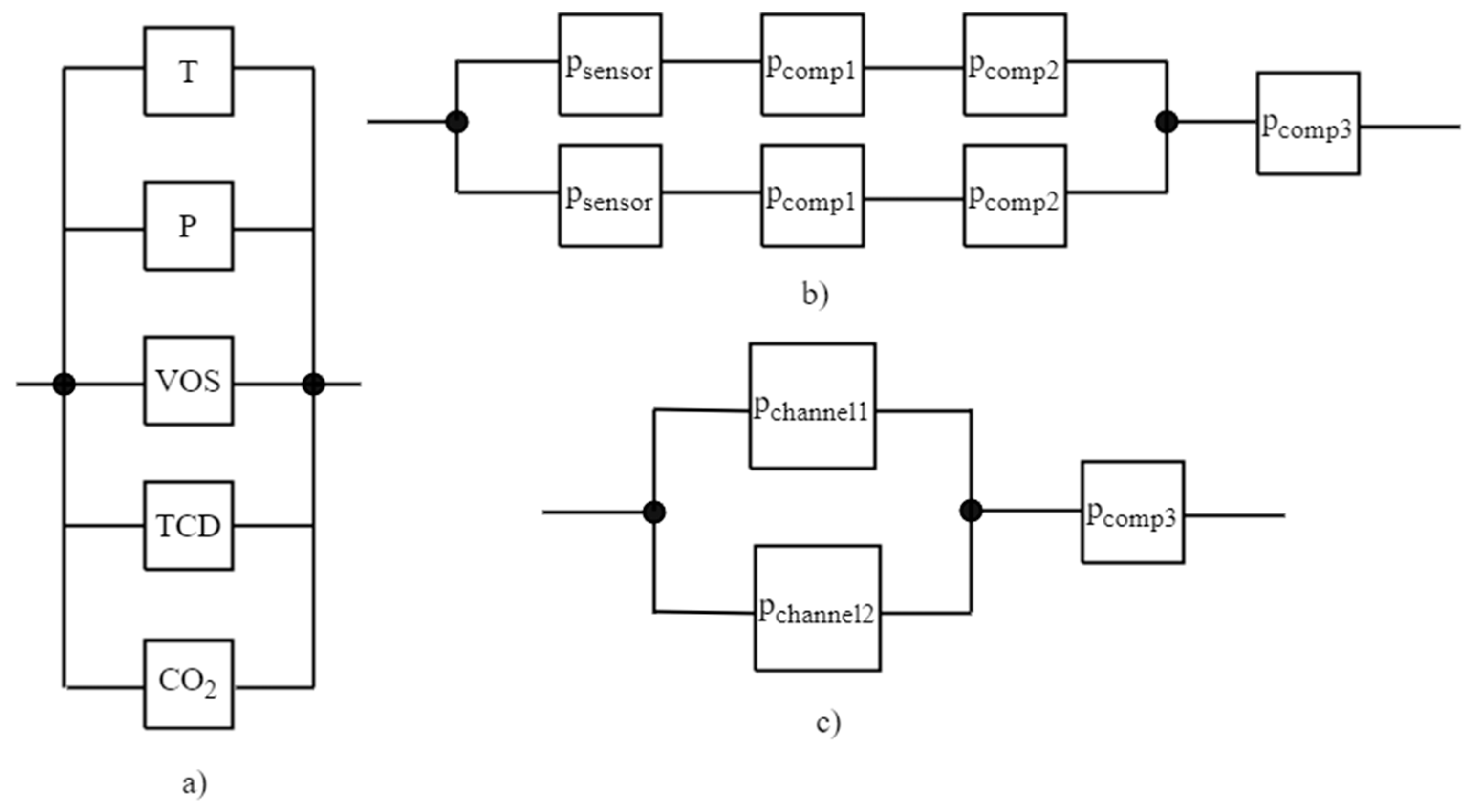
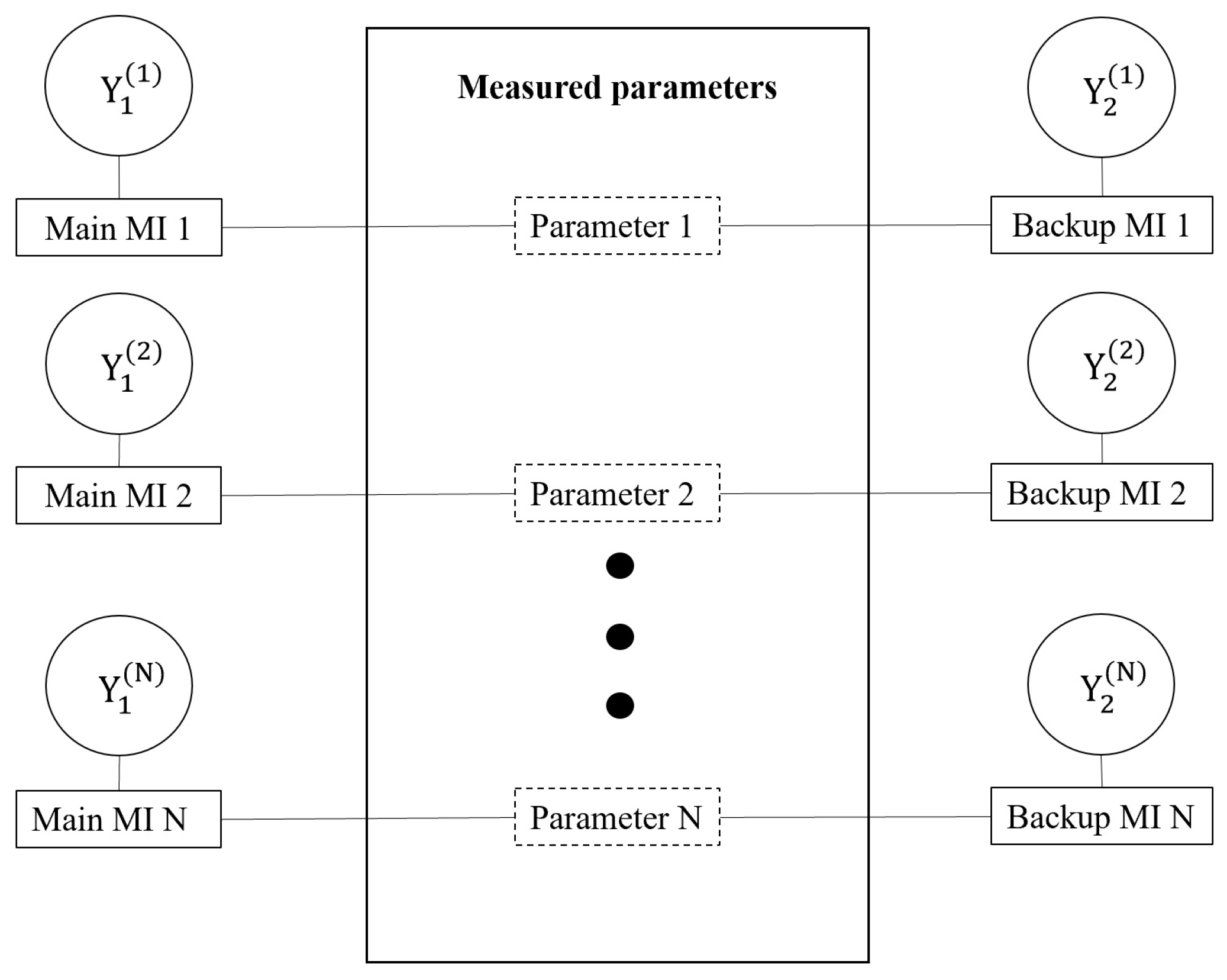

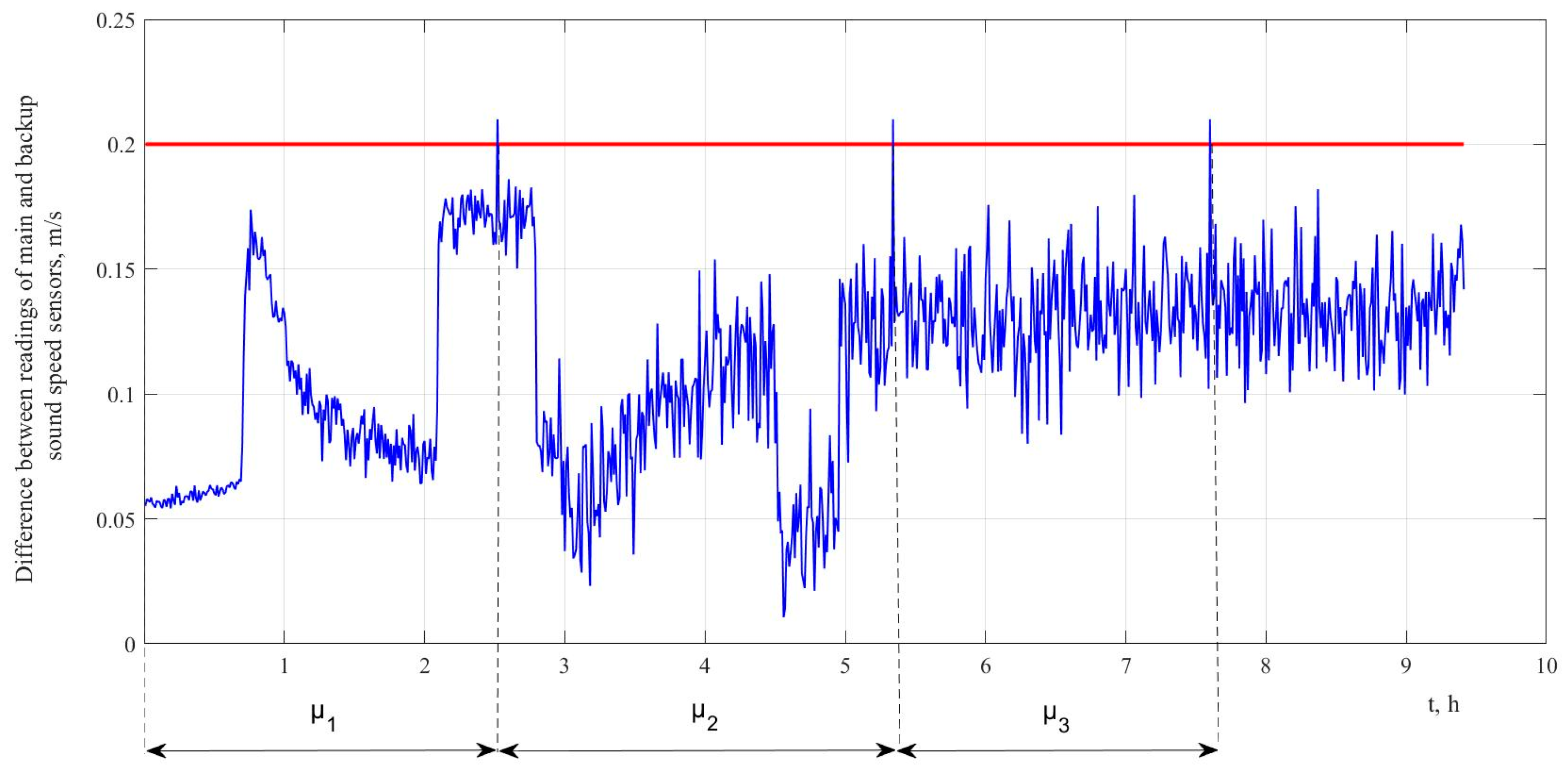
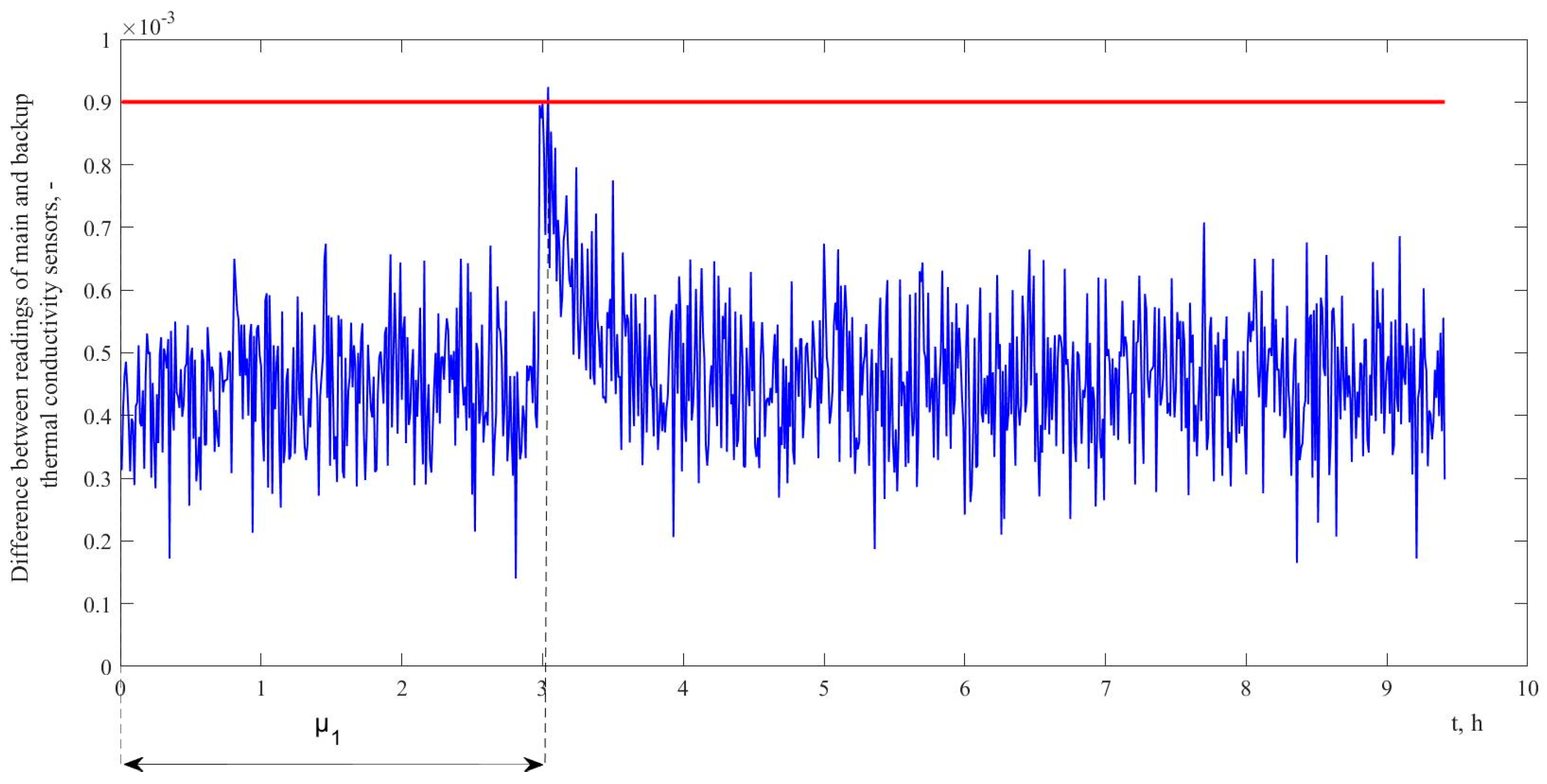
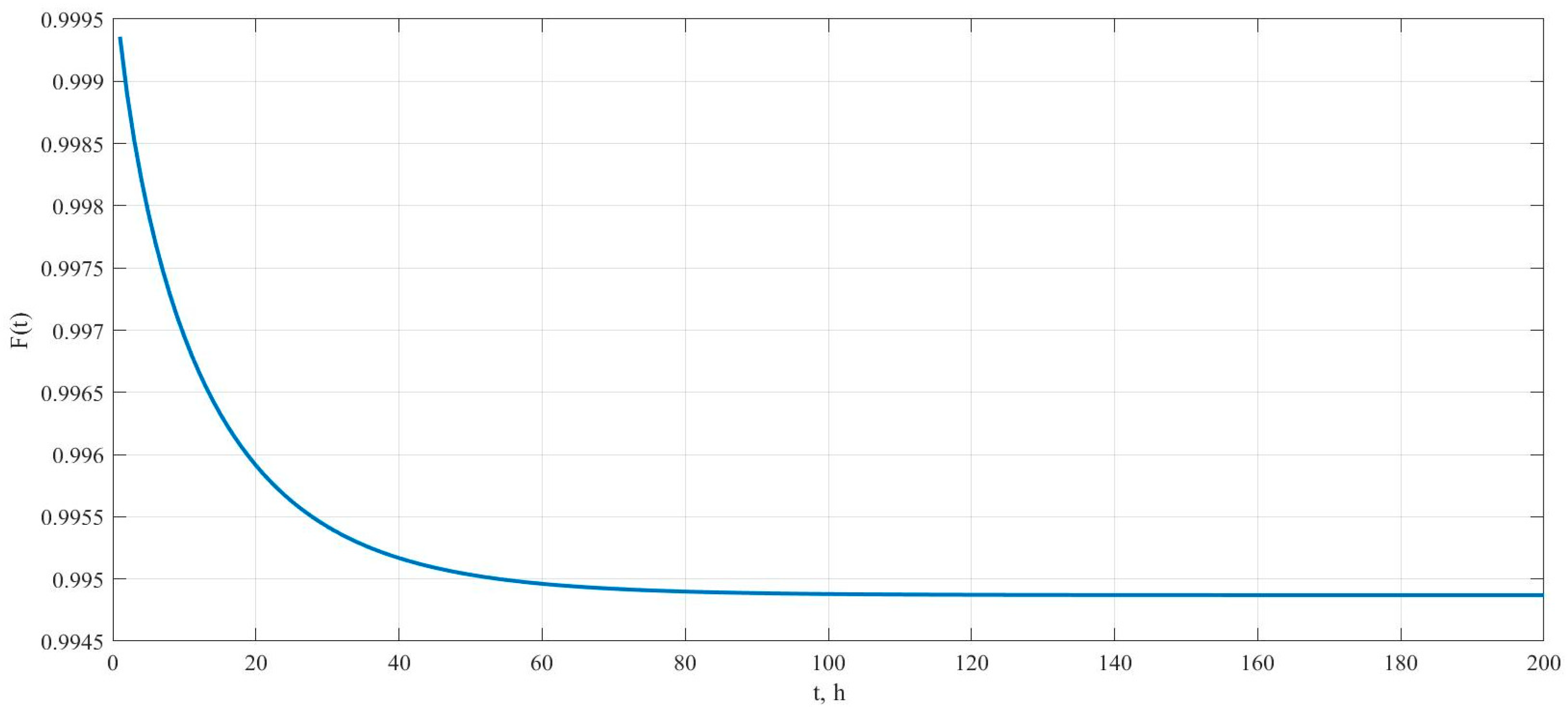
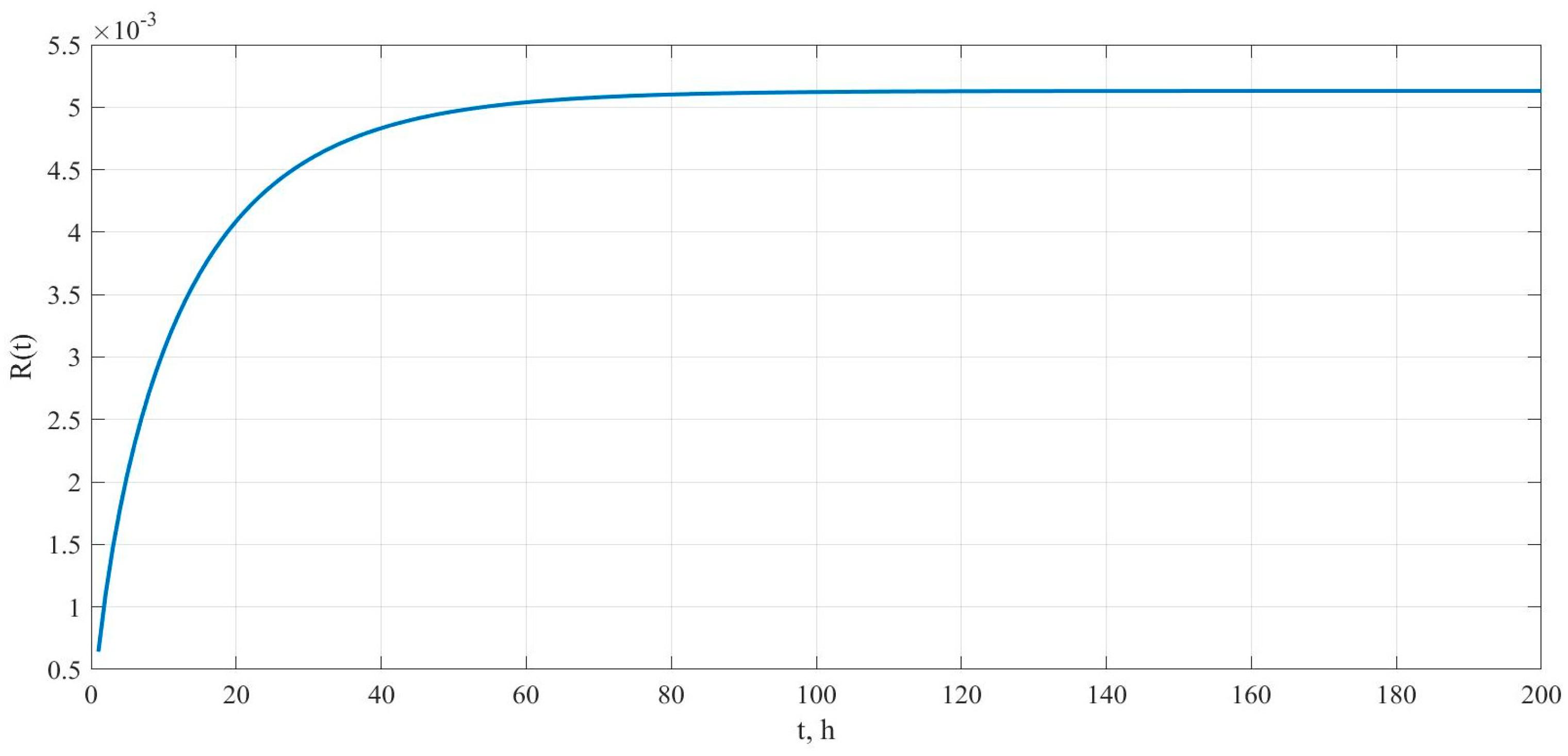
| Parameter | Variable | Value (1/h) |
|---|---|---|
| Failure rate of temperature sensor | λT | 5 × 10−5 |
| Failure rate of pressure sensor | λP | 5 × 10−5 |
| Failure rate of sound speed sensors | λVOS | 6.7 × 10−5 |
| Failure rate of thermal conductivity sensors | λTCD | 6.7 × 10−5 |
| Failure rate of carbon dioxide concentration sensors | λCO2 | 6.7 × 10−5 |
| Recovery rate for sensors | μsensor | 0.1 |
| Recovery intensity for systems to collect, process, and analyze information | μcomp | 0.05 |
| Computer failure rate | λcomp | 3.9 × 10−5 |
| Physical Gas Parameter | Unit | Threshold Value of Ai |
|---|---|---|
| Methane concentration (XCH4) | Mole fraction (%) | 0.1 |
| Propane concentration (XC3H8) | Mole fraction (%) | 0.1 |
| Nitrogen concentration (XN2) | Mole fraction (%) | 0.1 |
| Carbon dioxide concentration (XCO2) | Mole fraction (%) | 0.1 |
| Speed of sound (c) | m/s | 0.2 |
| Thermal conductivity (χ) | W/m K | 0.009 |
| Criterion | Developed System | Existing Systems |
|---|---|---|
| Order of analysis time (s) | 100 | 103 |
| Accuracy (MJ/m3) | ≈±0.5 | ±(0.1–0.2) |
| Order of cost (thousand RUB) | 102 | 103 |
| Mean time to failure of technical components (h) | ≈2.6 × 104 | ≈104 |
Disclaimer/Publisher’s Note: The statements, opinions and data contained in all publications are solely those of the individual author(s) and contributor(s) and not of MDPI and/or the editor(s). MDPI and/or the editor(s) disclaim responsibility for any injury to people or property resulting from any ideas, methods, instructions or products referred to in the content. |
© 2023 by the authors. Licensee MDPI, Basel, Switzerland. This article is an open access article distributed under the terms and conditions of the Creative Commons Attribution (CC BY) license (https://creativecommons.org/licenses/by/4.0/).
Share and Cite
Farhadov, M.; Vaskovskii, S.; Brokarev, I.; Ghorbani, S.; Reza Kashyzadeh, K. Quality Analysis of Natural Gas Using the Structural Reliability of an Analytical Information System. Mathematics 2023, 11, 3238. https://doi.org/10.3390/math11143238
Farhadov M, Vaskovskii S, Brokarev I, Ghorbani S, Reza Kashyzadeh K. Quality Analysis of Natural Gas Using the Structural Reliability of an Analytical Information System. Mathematics. 2023; 11(14):3238. https://doi.org/10.3390/math11143238
Chicago/Turabian StyleFarhadov, Mais, Sergei Vaskovskii, Ivan Brokarev, Siamak Ghorbani, and Kazem Reza Kashyzadeh. 2023. "Quality Analysis of Natural Gas Using the Structural Reliability of an Analytical Information System" Mathematics 11, no. 14: 3238. https://doi.org/10.3390/math11143238
APA StyleFarhadov, M., Vaskovskii, S., Brokarev, I., Ghorbani, S., & Reza Kashyzadeh, K. (2023). Quality Analysis of Natural Gas Using the Structural Reliability of an Analytical Information System. Mathematics, 11(14), 3238. https://doi.org/10.3390/math11143238









